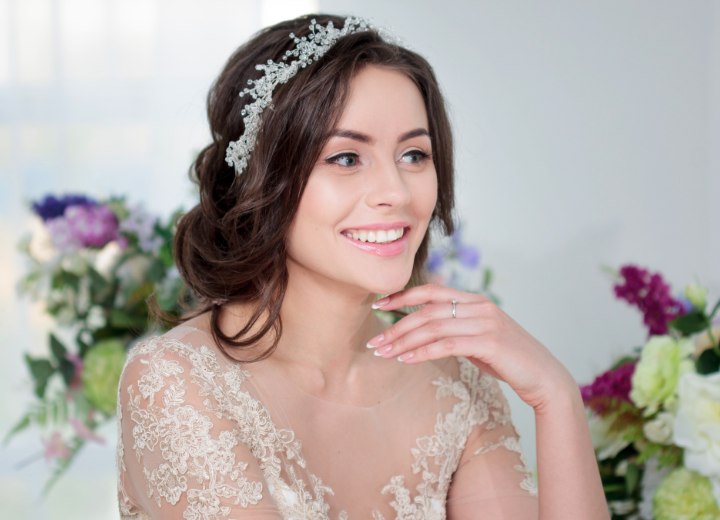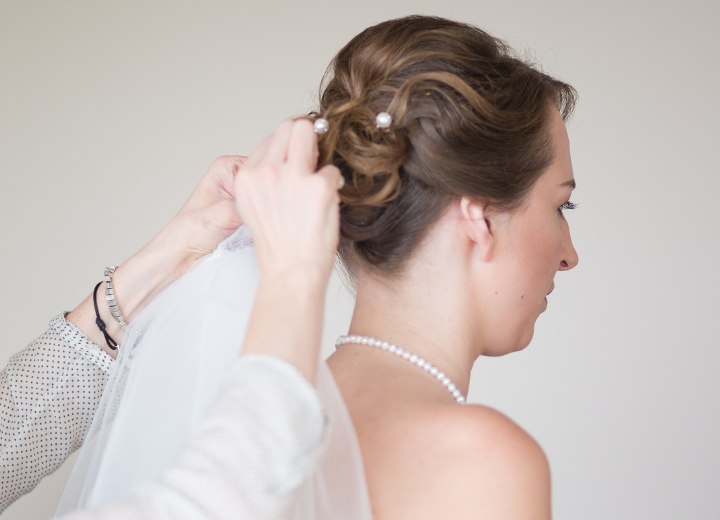A Brief Guide to Wedding Hairdos (2)

The Fall
In a classic fall, the hair in the top and sides is gathered loosely and usually secured in the area of the forward crown section. The remainder of the hair is worn loosely and allowed to fall down the back. The loose hair is often curled for volume and detail, and in cases where an individual’s natural hair is thin or sparse, extensions can be used to create more fullness. Some women even opt to make use of hairpieces and wiglets to further enhance their appearance.
As with other hairstyles that have a vertical focus, the fall is a nice option for those with a round face and features, as it helps to elongate the silhouette.
The swing is a reversal of the fall hairstyle in that the hair of the nape and crown sections are confined and secured in an updo while the top and side sections are worn loosely. This loose forward portion may be curled into a frame for the face, or otherwise arranged to give the hair visual interest. Granted, the look is not common in those with exceptionally long hair, as the forward-hanging sections could be unflattering with too much length.
Depending on the specifics of the cut and styling, the swing look can suit a wide range of face shapes. Allowing the forward sections to frame the face can help balance features and camouflage more challenging facial structures.
Full Upstyles
Full upstyles obviously utilize almost all of the hair in their construction. These two typical looks are the foundations upon which most full upstyles are based. They characterize the upstyle based on the level of detail and the tightness of the style.
The Loose Upstyle
A loose upstyle is generally used with those whose hair is less dense or those who desire a lot of volume. The hair is often backcombed to build up the interior structure and has the outer layers of the hair directed over this volume. Common loose upstyle looks can be seen in photos from the turn of the century and, because of this classic characterization, are often chosen by brides whose gowns are inspired by the fashions of that era.
The level of detail in a loose upstyle can vary greatly, but generally speaking, the details tend to be softer and minimalist. Common elements in a loose upstyle include a soft bun wound at the crown section with the peripheral sections backcombed for fullness and swept in curving lines to the crown. The silhouette is often overlarge but provides a counterpoint to both the gown being worn and the general body shape.

Taut upstyles are perhaps the most popular hairdos for many bridal environments. The hair is secured well against weather and other environmental factors, and the looks tend to be long-lasting as a result. The taut styles are, as with the other types, widely varied. They include looks like the simple chignon, the French twist, and the top-knot bun.
Taut upstyles also include any style that secures the hair closely to the scalp - or at least keeps the hair well-controlled and confined. At most, with a taut updo, a few tendrils will be worn loosely as adornment. Most curls will be carefully sculpted and will make a dramatic statement in detail and visual interest. As a result of the variety of styling options, the taut upstyle is often the most popular hairstyle type worn by brides.
All in all, bridal hairstyles are much like any other formal style, but they do have characteristics that make them unique. Most bridal hairdos are designed to incorporate a tiara, headpiece, or veil. Brides generally want to feel like princesses on their wedding day, so they opt for ornate and elaborate looks that are basically once-in-a-lifetime occurrences.